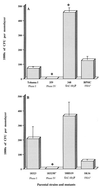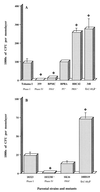Role of adhesins and toxins in invasion of human tracheal epithelial cells by Bordetella pertussis
- PMID: 10722585
- PMCID: PMC97369
- DOI: 10.1128/IAI.68.4.1934-1941.2000
Role of adhesins and toxins in invasion of human tracheal epithelial cells by Bordetella pertussis
Abstract
Bordetella pertussis, the agent of whooping cough, can invade and survive in several types of eukaryotic cell, including CHO, HeLa 229, and HEp-2 cells and macrophages. In this study, we analyzed bacterial invasiveness in nonrespiratory human HeLa epithelial cells and human HTE and HAE0 tracheal epithelial cells. Invasion assays and transmission electron microscopy analysis showed that B. pertussis strains invaded and survived, without multiplying, in HTE or HAE0 cells. This phenomenon was bvg regulated, but invasive properties differed between B. pertussis strains and isolates and the B. pertussis reference strain. Studies with B. pertussis mutant strains demonstrated that filamentous hemagglutinin, the major adhesin, was involved in the invasion of human tracheal epithelial cells by bacteria but not in that of HeLa cells. Fimbriae and pertussis toxin were not found to be involved. However, we found that the production of adenylate cyclase-hemolysin prevents the invasion of HeLa and HTE cells by B. pertussis because an adenylate cyclase-hemolysin-deficient mutant was found to be more invasive than the parental strain. The effect of adenylate cyclase-hemolysin was mediated by an increase in the cyclic AMP concentration in the cells. Pertactin (PRN), an adhesin, significantly inhibited the invasion of HTE cells by bacteria, probably via its interaction with adenylate cyclase-hemolysin. Isolates producing different PRNs were taken up similarly, indicating that the differences in the sequences of the PRNs produced by these isolates do not affect invasion. We concluded that filamentous hemagglutinin production favored invasion of human tracheal cells but that adenylate cyclase-hemolysin and PRN production significantly inhibited this process.
Figures






References
-
- Arico B, Gross R, Smida J, Rappuoli R. Evolutionary relationships in the genus Bordetella. Mol Microbiol. 1987;1:301–308. - PubMed
-
- Arico B, Scarlato V, Monack D M, Falkow S, Rappuoli R. Structural and genetic analysis of the bvg locus in Bordetella species. Mol Microbiol. 1991;5:2481–2491. - PubMed
-
- Boursaux-Eude C, Thiberge S, Carletti G, Guiso N. Intranasal murine model of Bordetella pertussis infection. II. Sequence variation and protection induced by a tricomponent acellular vaccine. Vaccine. 1999;17:2651–2660. - PubMed
Publication types
MeSH terms
Substances
LinkOut - more resources
Full Text Sources
Other Literature Sources

